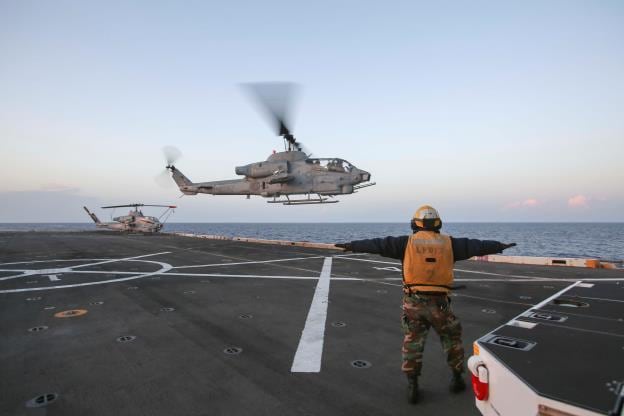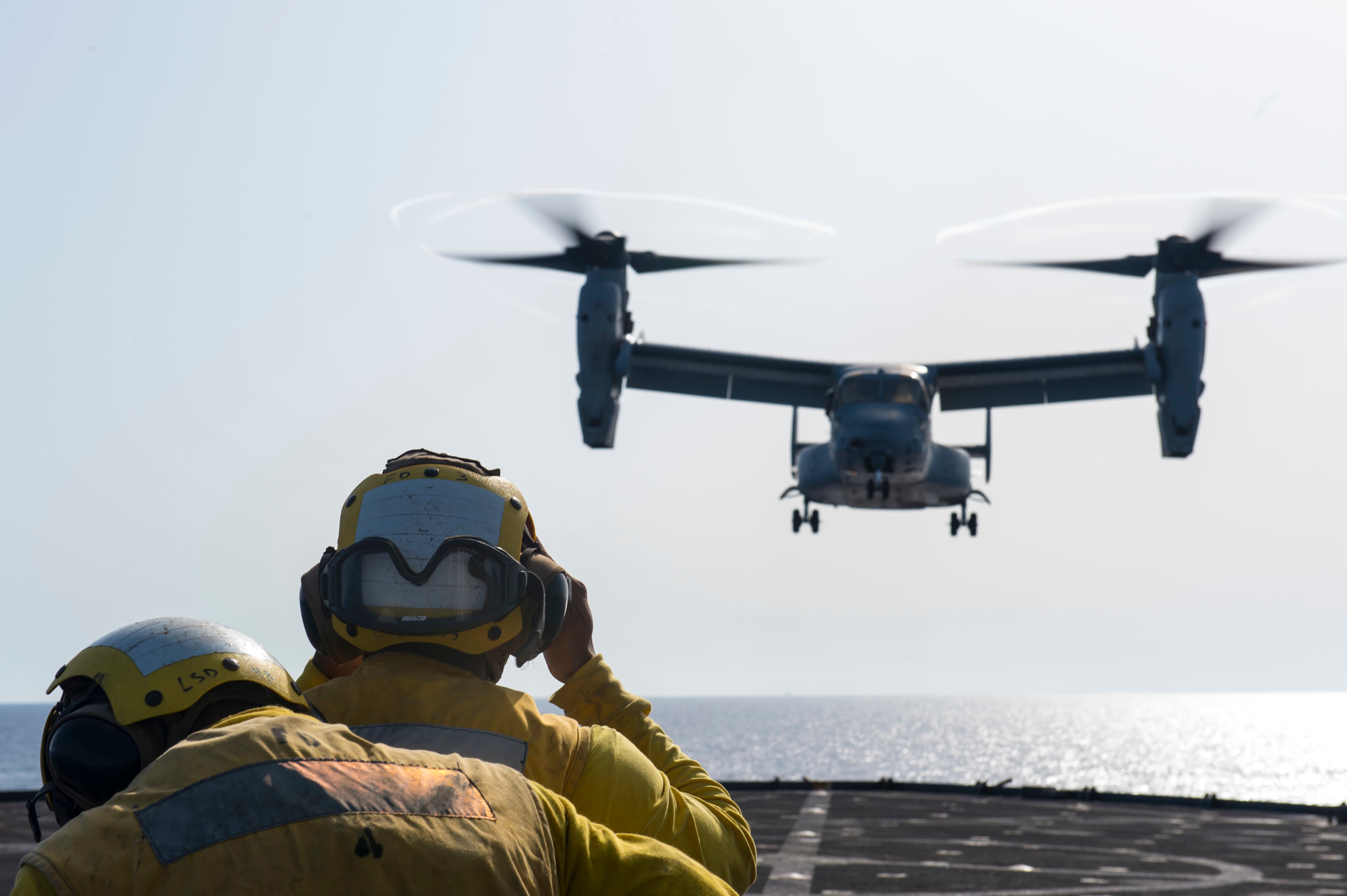As the security situation in Yemen began to rapidly deteriorate in early 2015, the 24th Marine Expeditionary Unit kicked into high gear, providing close-air support assets while aiding in the evacuation of U.S. personnel and the movement of Yemen’s president, according to U.S. military documents.
The exploits of the 24th MEU’s support to Yemen during the early stages of the country’s civil war were detailed in a command chronology obtained by Marine Corps Times through a government records request.
The records reveal an extensive level of involvement by the MEU in the war-torn country — even as its forces were spread thinly across the Middle East supporting multiple multinational training exercises and anti-ISIS missions in support of Operation Inherent Resolve.
As the country slipped deeper into chaos, Marines with the MEU were tasked with supporting the evacuation of special operation forces and American government personnel and also the evacuation of Yemen’s President Abdrabbuh Mansour Hadi.
A listing of “significant events” in the chronology notes that the MEU supported the “evacuation” of Hadi on March 26, 2015, but provided no other details of what that support entailed or where Hadi was moved.
On March 20, 2015, Aljazeera reported that Hadi had fled his presidential palace in Aden after it was attacked by unidentified aircraft.
A civil war has split Yemen between Iran-backed Houthi rebels and supporters of Hadi’s government following a failed power handover between Ali Abdullah Saleh and Hadi. Yemen’s capital of Sanaʽa has been controlled by the Houthis since February 2015. The ongoing conflict has been exploited by ISIS and al-Qaida militants in ungoverned spaces across the country.
As the conflict spilled into Sanaʽa, the U.S. shuttered its embassy in February 2015, prompting Marines floating near Yemen’s coast aboard the amphibious assault ship Iwo Jima to aid the departure of American personnel with airborne quick reaction troops and command and control support for joint forces assisting with the withdrawal efforts.
RELATED

“February saw continued contingency planning efforts as the security situation in Yemen continued to deteriorate, leading to the closing of the U.S. embassy and the departure of Department of State and defense personnel,” the MEU chronology states.
By March 2015, Marines with the Iwo Jima and San Antonio-class amphibious transport dock New York were tasked to support the withdrawal of special operations forces in Yemen from “their compound in Aden as well as Qatan Air Base,” the command chronology for the 24th MEU reads.
“The New York steamed to a location off the coast of Aden” in March 2015, to “posture” for potential casualty evacuations, among other contingencies, according to the chronology.
The command record of the MEU’s historical events in Yemen did not specify if the evacuated special operations forces were American troops. But, CNN reported on March 23, 2015, that the U.S. pulled out Navy SEALs and Army Delta Force members from the Al Anad airbase as part of a temporary relocation. Al Anad is located just north of Aden, Yemen.
American forces have been assisting the Yemen government for years to combat al-Qaida’s Yemen offshoot known as al-Qaida in the Arabian Peninsula, or AQAP.
“In coordination with the government of Yemen, U.S. forces are supporting ongoing counterterrorism operations in Yemen against AQAP and ISIS to degrade their ability to coordinate external terror attacks and limit their ability to hold territory," Army Lt. Col. Earl Brown, a spokesman with U.S. Central Command told Marine Corps Times.
By March 22, 2015, Marines with the Iwo Jima and New York were providing fixed-wing close-air support assets, forces for potential casualty evacuations and “tiltrotor and rotary wing support for the withdrawal of Security Forces Yemen,” the chronology reads.

MEU aircraft also “directly supported” the movement of the U.S. ambassador to Yemen in and out of the country on two dates, March 2, 2015, and March 11, 2015. The chronology did not name the U.S. ambassador, but Matthew H. Tueller was the American ambassador to Yemen when the embassy was closed in 2015. Tueller is now the U.S. ambassador to Iraq.
In April 2015, the Iwo Jima was floating off the coast of Djibouti when it welcomed a visit by the commander of special operations command Yemen, who discussed with the MEU support operations in Yemen and the Gulf of Aden.
On April 19, 2015, the Iwo Jima conducted a “show of presence” operation with rotary and fixed-wing aircraft against an Iranian convoy suspected of carrying arms for Houthi rebels, according to the chronology. The Iranian arms convoy eventually reversed its course.
The MEU’s extensive support to operations in Yemen was carried out while its forces and ships were spread across a vast geographic terrain across the Middle East.
In February 2015, the MEU noted in its chronology that about 1,250 Marines were spread across five countries, even as Yemen contingency planning and posturing was underway.
During that busy month, there were Marines training in Bahrain and Kuwait doing sniper and sustainment training, and Marines embarked with the Whidbey Island-class dock landing ship were conducting assault amphibious vehicle and urban operations training as part of exercises Iron Magic in the United Arab Emirates.
The civil war in Yemen is still raging. The BBC reported that government forces aligned to Hadi have reentered Aden in an ongoing tit-for-tat fight for control of the southern city.
Shawn Snow is the senior reporter for Marine Corps Times and a Marine Corps veteran.




